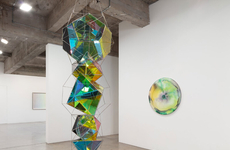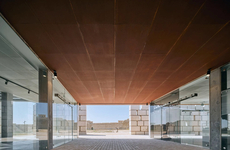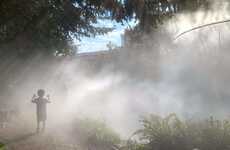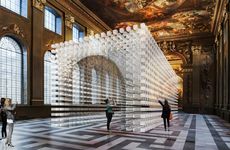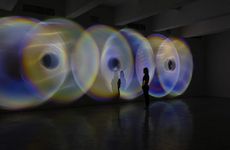
OCULUS is Inspired by the Istanbul Imperial Arsenal
Joey Haar — June 23, 2017 — Art & Design
References: archdaily
From the 16th century through until the fall of the Ottoman Empire, the Istanbul Imperial Arsenal served as the home base and naval shipyard for that transcontinental superpower. Given the striking history of such a place, OCULUS, a futuristic audio-visual installation on display as part of the Third Istanbul Biennial, attempts to blend its message with the significance of its location.
The key theme of OCULUS, one that is immediately clear upon viewing it within the context of the Istanbul Imperial Arsenal hall, is that of juxtaposition. While the building in which its housed is an exemplary showing of 16th-century Ottoman architecture, the installation itself is a geometric shape that could hardly have been conceived of during the Renaissance. Further, the sonic and visual displays pumped into and projected onto the installation add to the abrupt contrast.
The key theme of OCULUS, one that is immediately clear upon viewing it within the context of the Istanbul Imperial Arsenal hall, is that of juxtaposition. While the building in which its housed is an exemplary showing of 16th-century Ottoman architecture, the installation itself is a geometric shape that could hardly have been conceived of during the Renaissance. Further, the sonic and visual displays pumped into and projected onto the installation add to the abrupt contrast.
Trend Themes
1. Historic Audio-visual Installations - Disruptive innovation opportunity: Explore the integration of historical spaces with futuristic audio-visual installations to create immersive experiences.
2. Juxtaposition in Design - Disruptive innovation opportunity: Embrace the power of contrast by combining traditional and modern elements in design to create visually impactful installations.
3. Geometric Shapes in Renaissance-inspired Spaces - Disruptive innovation opportunity: Experiment with geometric shapes and contemporary designs in historically significant locations to challenge traditional aesthetics.
Industry Implications
1. Art and Exhibition - Disruptive innovation opportunity: Incorporate audio-visual installations into art exhibitions to create interactive and immersive experiences for visitors.
2. Architecture and Heritage - Disruptive innovation opportunity: Integrate technological advancements into historical architecture to revitalize heritage spaces and attract a wider audience.
3. Event Planning and Tourism - Disruptive innovation opportunity: Organize unique audio-visual installations within historic venues to enhance event experiences for tourists and locals alike.
3.3
Score
Popularity
Activity
Freshness



